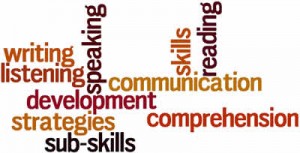What Are Communication Disorders?

What Are Communication Disorders? Are They The Same As Speech Disorders? Image Courtesy of developingcourses.com
Last week, we helped you identify the symptoms associated with five common types of speech disorder. There are a handful of disorders that are not considered speech disorders, yet still effect a child’s ability to speak and communicate. Today we discuss a few of these conditions. These are classified under “communication disorders” rather than speech disorders because often the causes are unknown and they effect more than just a child’s speaking ability.
A communication disorder is a speech and language disorder which refers to problems in communication and in related areas such as oral motor function. These delays and disorders can range from simple sound substitution to the inability to understand or use native language. In general, communications disorders refer to problems in speech (comprehension and/or expression) that significantly interfere with an individual’s achievement and/or quality of life.
Included in this list is hearing loss, neurological disorders, brain injury, physical impairments such as cleft lip or palate, emotional or psychiatric disorders, and developmental disorders. It is estimated that one in every 10 Americans, across all ages, races and genders, has experienced or lived with some type of communication disorder (including speech, language and hearing disorders). Nearly 6 million children under the age of 18 have a speech or language disorder.
Three Examples of Communication Disorders:
Expressive Language Disorder. This is characterized by difficulty expressing oneself beyond simple sentences and a limited vocabulary. An child may understand language better than he is a able to speak communicate it, he may have a lot to say but have difficulties organizing and retrieving the words to get an idea across beyond what is expected for his/her developmental stage.
Voice disorders, another type of communication disorder, relate to difficulties with the quality, pitch and loudness of the voice (prosody). People with voice disorders may have trouble with the way their voices sound. Many people who have acquired normal speaking skills become communicatively impaired when their vocal system fails. This can occur if the nerves controlling the functions of the larynx are impaired as a result of an accident, a surgical procedure or a viral infection
Auditory processing disorder is the term used to describe what happens in a child’s brain when it recognizes and interprets the sounds around him. The “disorder” part of auditory processing disorder (APD) means that something is adversely affecting the processing or interpretation of information. Children with APD often do not recognize subtle differences between sounds in words, even though the sounds themselves are loud and clear. For example, the request “Tell me how a couch and a chair are alike” may sound to a child with APD like “Tell me how a cow and a chair are alike.” It can even be understood by the child as “Tell me how a cow and a hair are alike.” These kinds of problems are more likely to occur when a person with APD is in a noisy environment or when he or she is listening to complex information. Children with APD typically have normal hearing and intelligence.
APD goes by many other names. Sometimes it is referred to as central auditory processing disorder (CAPD). Other common names are auditory perception problem, auditory comprehension deficit, central auditory dysfunction, central deafness and so-called “word deafness.”
If you are concerned that your child is exhibiting the above symptoms, we encourage you to discuss with your pediatrician.
For Additional Resources:
American Speech-Language-Hearing Association Child Speech and Language Development
Free eBook: A Parent’s Guide to Speech & Communication Challenges


